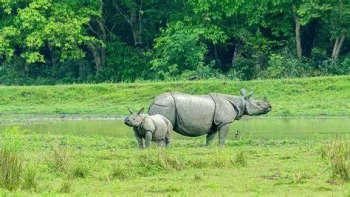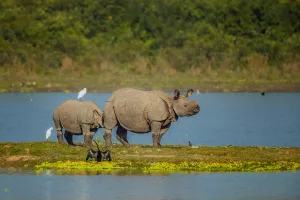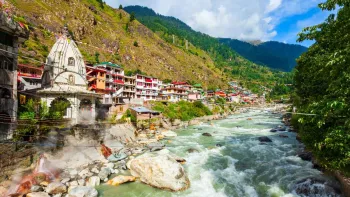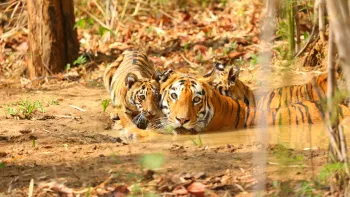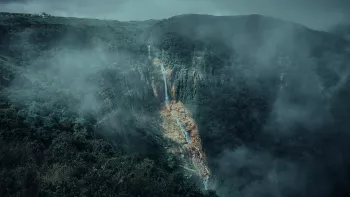Nanda Devi National Park
Duration
5 to 7 Days
5 to 7 Days
Best time to visit
May-Jun, Sep-Oct
May-Jun, Sep-Oct
Theme
Hill Station, Wildlife
Hill Station, Wildlife
Nanda Devi National Park Travel Guide
Nanda Devi National Park, located in the state of Uttarakhand in India, is a UNESCO World Heritage Site known for its stunning beauty and rich biodiversity. The park is named after Nanda Devi, the second-highest mountain in India, and is surrounded by towering peaks and lush valleys. This region holds great cultural significance for the local communities, and it is a popular destination for trekking and wildlife enthusiasts.Top Attractions in Nanda Devi National Park
- Nanda Devi Peak
- Valley of Flowers National Park
- Rishi Ganga River
- Joshimath
- Nanda Devi East Base Camp
Nanda Devi National Park is Famous for
Its pristine natural beauty and being home to the Nanda Devi Peak, the second-highest mountain in India.Top Attractions in Nanda Devi National Park
- Explore the majestic Nanda Devi Peak
- Discover the vibrant Valley of Flowers National Park
- Experience the serenity of Rishi Ganga River
- Visit the spiritual town of Joshimath
- Trek to the Nanda Devi East Base Camp for breathtaking views
What's Great about Travelling to Nanda Devi National Park?
- Perfect for nature lovers and adventure seekers
- Breathtaking views of the Himalayas
- Opportunity to witness unique flora and fauna
What's Not So Great about Travelling to Nanda Devi National Park?
- Challenging terrain for inexperienced trekkers
- Limited accommodation options
- Remote location may require thorough planning
Travel Tips for Nanda Devi National Park
- Obtain necessary permits for trekking in advance
- Pack appropriate gear for varying weather conditions
- Respect the local culture and environment
Important Nanda Devi National Park trip information
- Ideal Duration: 5-7 days to explore the main attractions
- Best Time to Visit: May to October for pleasant weather
- Nearby Airports and Railway Stations: The nearest airport is in Dehradun and the nearest railway station is in Rishikesh
Per Person
40,000
*EXCLUDING APPLICABLE TAXES Per Person
24,400
*EXCLUDING APPLICABLE TAXES Per Person
15,000
*EXCLUDING APPLICABLE TAXES Per Person
19,900
*EXCLUDING APPLICABLE TAXES 4.2 Ratings
( 41 Reviews )
( 41 Reviews )
Per Person
18,000
*EXCLUDING APPLICABLE TAXES Per Person
16,500
*EXCLUDING APPLICABLE TAXES 5.0 Ratings
( 9 Reviews )
( 9 Reviews )
FAQ's on Nanda Devi National Park
Q1: What is the best time to visit Nanda Devi National Park?
The best time to visit Nanda Devi National Park is during the summer months from May to June and then again in the post-monsoon period from September to October. These months offer pleasant weather, clear skies, and ideal trekking conditions. Avoid visiting during the monsoon season from July to August due to heavy rainfall which can lead to landslides and road closures.
Q2: Do I need a visa to travel to Nanda Devi National Park?
As Nanda Devi National Park is located in India, most tourists will require a valid Indian visa to visit. Check with your local Indian embassy or consulate for specific visa requirements based on your nationality. Some travelers may be eligible for an e-visa or visa on arrival, but it's essential to verify this information before your trip.
Q3: What are the must-visit attractions in Nanda Devi National Park?
Nanda Devi National Park is renowned for its stunning Himalayan landscapes, diverse flora, and fauna. Some of the must-visit attractions include the Nanda Devi Peak, Valley of Flowers, Hemkund Sahib, Auli for skiing, and Badrinath Temple. Trekking enthusiasts can explore the Nanda Devi Sanctuary, a UNESCO World Heritage Site, for breathtaking views and unique wildlife sightings.
Q4: Is Nanda Devi National Park a safe place to travel?
Nanda Devi National Park is generally safe for travelers, but it's essential to be cautious while trekking or hiking due to the remote and rugged terrain. Follow safety guidelines, stick to marked trails, and hire experienced guides for treks. Avoid traveling during extreme weather conditions and respect wildlife in the park. As with any destination, it's advisable to be aware of your surroundings and take necessary precautions.
Q5: What is the local currency in Nanda Devi National Park and can I use credit cards?
The local currency in Nanda Devi National Park is the Indian Rupee (INR). While credit cards may be accepted in some hotels and larger establishments, it's recommended to carry cash for smaller purchases and in remote areas. ATMs are available in nearby towns like Joshimath and Rishikesh, so it's advisable to withdraw sufficient cash before heading into the park.
Q6: What is the local cuisine like in Nanda Devi National Park?
The local cuisine in Nanda Devi National Park offers a mix of traditional Garhwali and Kumaoni dishes. Popular items include rajma (kidney beans), bhatt ki churdkani (black soybean curry), aloo ke gutke (spicy boiled potatoes), and singori (sweet dessert). Visitors can also enjoy local teas like Buransh (rhododendron) and Adu (ginger). Be prepared for simple yet flavorful meals, often using locally sourced ingredients. Vegetarian options are predominant, reflecting the cultural preferences of the region.
Q7: What transportation options are available in Nanda Devi National Park?
Transportation options in Nanda Devi National Park are limited due to its remote location. Visitors can reach the park by road via Rishikesh or Joshimath and then hire local jeeps or taxis for further travel. Trekking is a common way to explore the park's interior, with experienced guides leading the way. Public buses and shared taxis are available for short distances, but private transport or hired vehicles offer more flexibility for exploring the region.
Q8: Are there any cultural norms or etiquette I should be aware of when visiting Nanda Devi National Park?
When visiting Nanda Devi National Park, it's important to respect the local customs and traditions of the Garhwali and Kumaoni communities. Dress modestly, especially when visiting religious sites or villages. Seek permission before taking photographs of locals, as some may prefer not to be photographed. Remove shoes before entering temples or homes, and greet people with a polite "Namaste." Avoid public displays of affection and be mindful of your behavior in sacred places. By showing respect for the local culture and environment, you can have a more enriching and meaningful experience in Nanda Devi National Park.
Q9: I am a travel agent. How can I buy travel leads of Nanda Devi National Park?
Register yourself as a travel agent at agents.tripclap.com and then you can buy travel leads to Nanda Devi National Park once your account is approved. For more details contact our support team at +91-8069186564 or support@tripclap.com
